Scaling up climate action in Indonesia
Attachments
Summary
Ini adalah halaman publikasi lengkap dalam bahasa Inggris. Untuk siaran pers Bahasa Indonesia, klik di sini. This is the full publications page in english. For the Bahasa Indonesia press release, click here.
Limiting global temperature increase to 1.5°C is highly relevant for Indonesia as, at 3% of global emissions (incl. LULUCF), it is among the world’s largest greenhouse gas emitters and expected to be among the worst affected by climate change. This report, the fourth country assessment in the Climate Action Tracker's Scaling Up Climate Action Series, analyses areas where Indonesia could accelerate its climate action. The report illustrates GHG emissions reductions from such actions, along with other benefits.
In Indonesia, there is tremendous potential to scale up climate action, especially in the focus areas of this study: electricity supply, passenger transport, and forestry. Increasing climate action now would initiate technically-feasible and socio-economically beneficial sectoral transitions towards a zero-emissions society while directly benefitting Indonesia’s sustainable development agenda.

Potential impact of scaling up climate action
Scaling up climate action in the electricity supply, passenger ground transport and forestry sectors, which together covered about 70% of Indonesia’s emissions in 2014, would lead to curbing emissions growth and could achieve a 20% reduction in emissions below 2010 by 2030. This stands in stark contrast to the currently projected 58-68% emissions increase under Indonesia’s Paris Agreement Nationally Determined Contribution (NDC). It would initiate Indonesia’s transition towards zero emissions in line with the Paris Agreement and peak Indonesian GHG emissions excluding deforestation and land use shortly after 2030.
To get on track toward Paris Agreement-compatible emissions reductions, Indonesia needs to urgently scale up climate action in the electricity and transport sectors, decarbonising them by 2050, with phasing out coal power generation, ramping up renewable energy generation and electrifying the growing transport fleet, as essential strategies. The Indonesian forestry sector has the single largest potential for reducing domestic emissions and Indonesia can turn its forestry sector into a net sink of carbon emissions by 2030 if takes significant steps to halt peat fires, reduce deforestation rates and restore degraded peatlands.
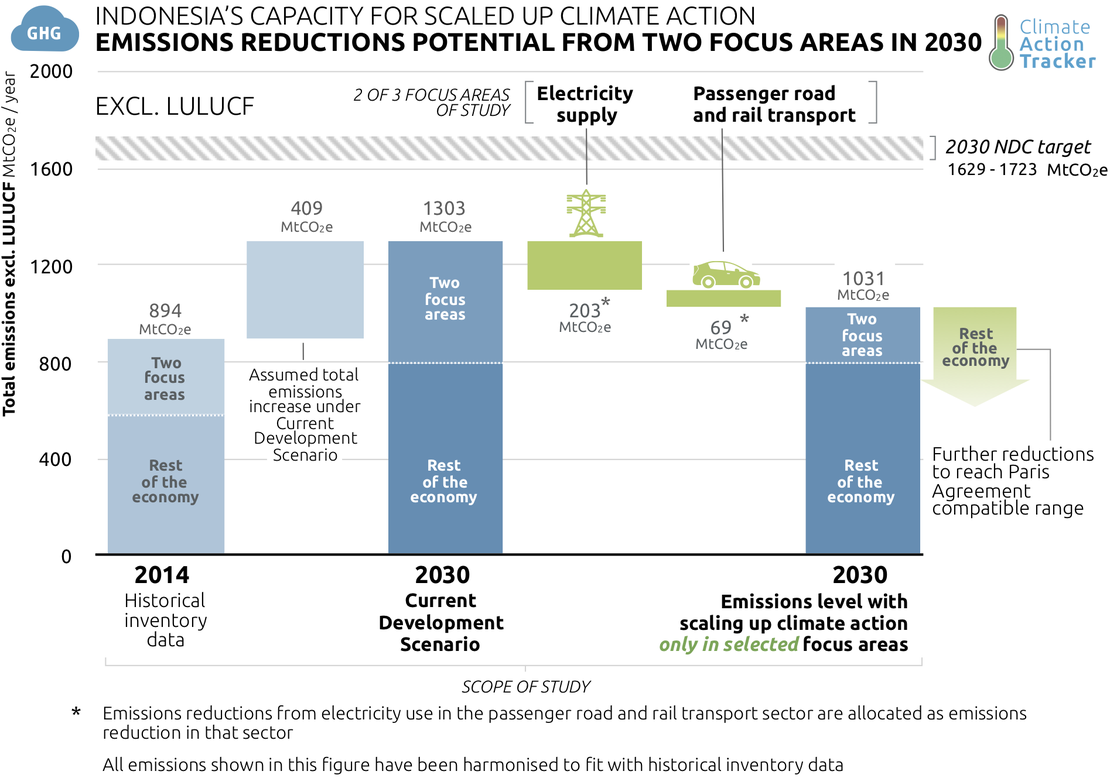
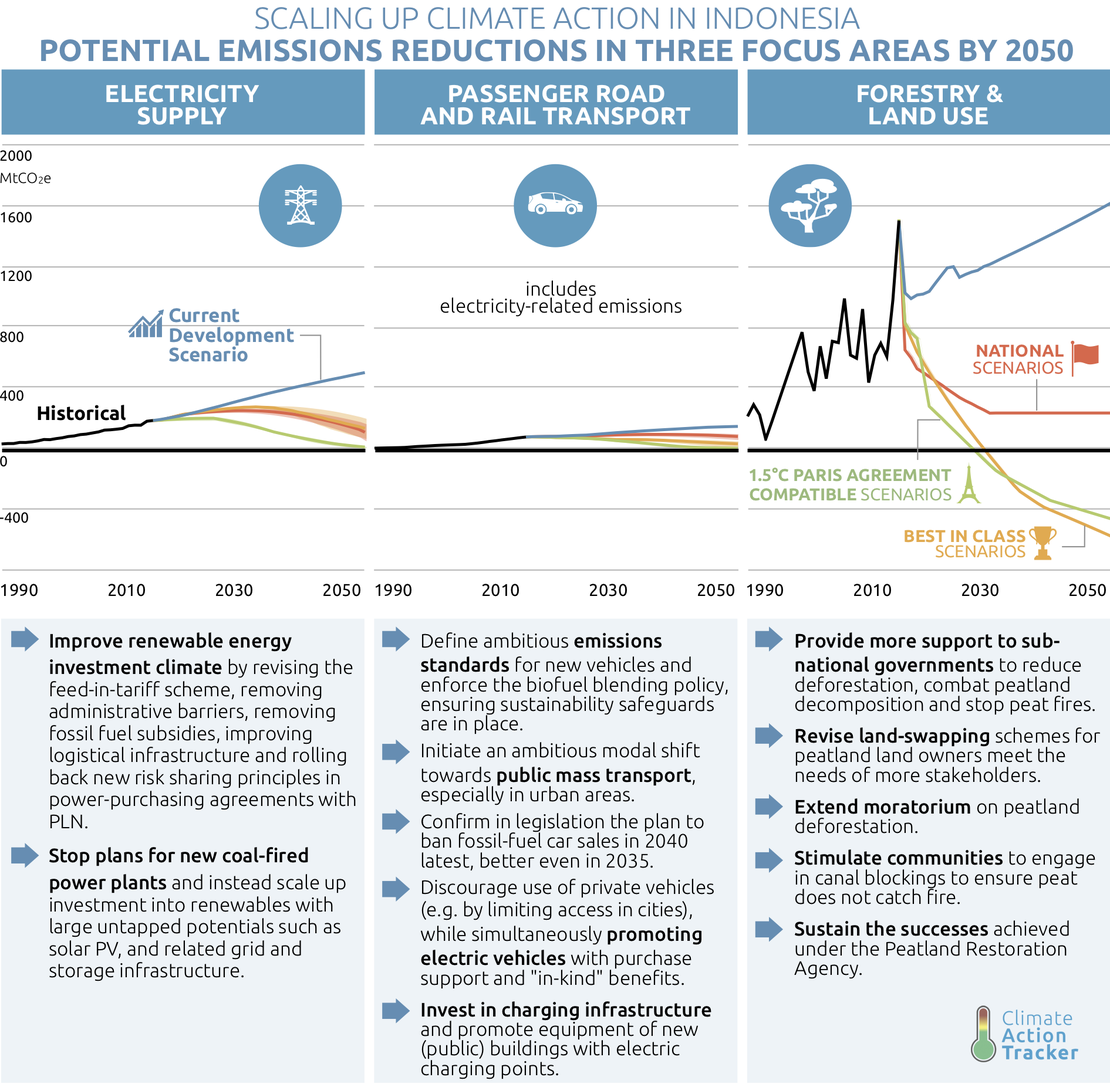
Electricity supply
To bring Indonesia in line with the Paris Agreement and with full decarbonisation of the power sector by 2050 requires a share of decarbonised electricity generation of 50–54% by 2030, with no new coal plants and coal phased out by 2040. The most promising way to full decarbonisation is for Indonesia to prioritise developing renewables to make up a share of around 50% by 2030 and 100% by 2050. Such a pathway would deliver the greatest societal benefits and avoid large-scale early retirement of new coal-fired power plants.
Decarbonising power is paramount to decarbonising other economic sectors. Electrifying Indonesian transport will only result in sufficiently large emission reductions when the domestic power supply is decarbonised.
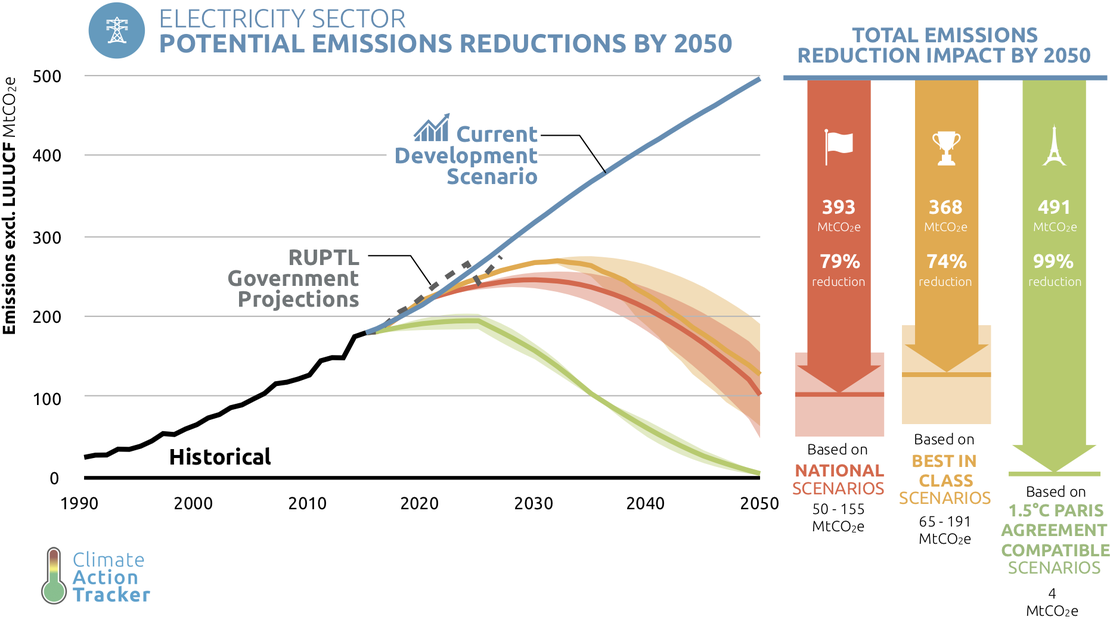
Ambitious climate policy in the Indonesian power sector can yield substantial employment benefits: development of solar PV will play a central role in a future low-carbon electricity system and our most ambitious renewables deployment scenario could create, on average, up to 290,000 additional direct jobs between 2020 and 2030.
Job losses in the domestic coal supply chain (after 2025) are expected to be largely outweighed by additional new jobs in building and operating new renewables capacity. This shift will require preparation now to ensure a Just Transition.
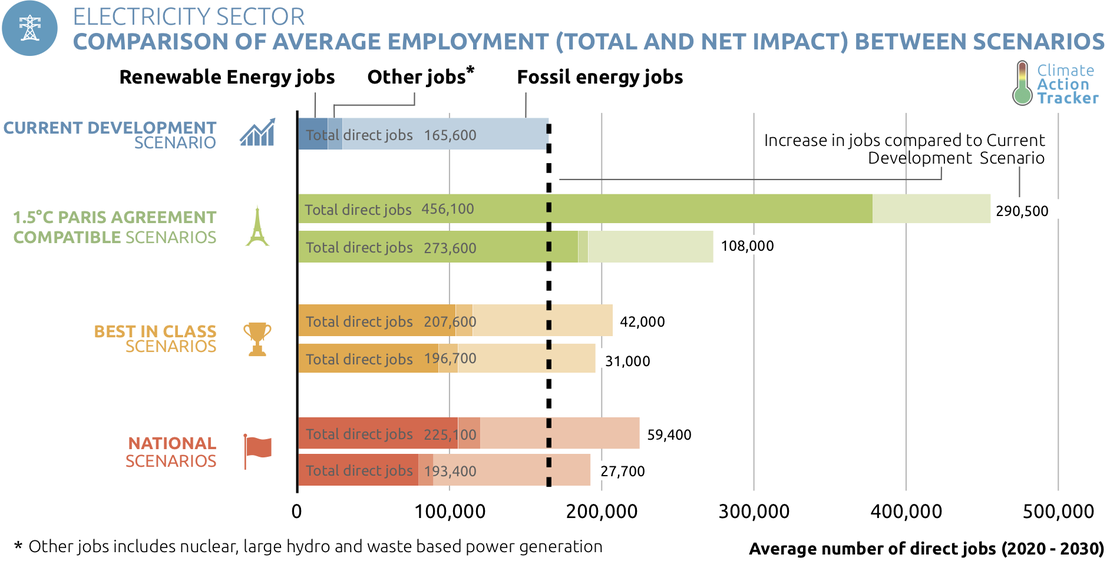
Passenger transport
As Indonesia’s GDP grows, passenger transport demand is expected to grow substantially until 2030, by around 3% annually. Fuel economy standards, developing public transport and introducing electric mobility are key measures to start decreasing passenger transport emissions in the short term.
Strong electrification of the passenger vehicle fleet, coupled with decarbonised electricity would enable decarbonisation of passenger transport and be in line with requirements of the Paris Agreement. Our most ambitious scenario assumes 100% electrification of the passenger vehicle fleet by 2050. Such an achievement would require going beyond, and sustaining, existing global best practices, e.g. the recent uptake of electric two-wheelers seen in China.
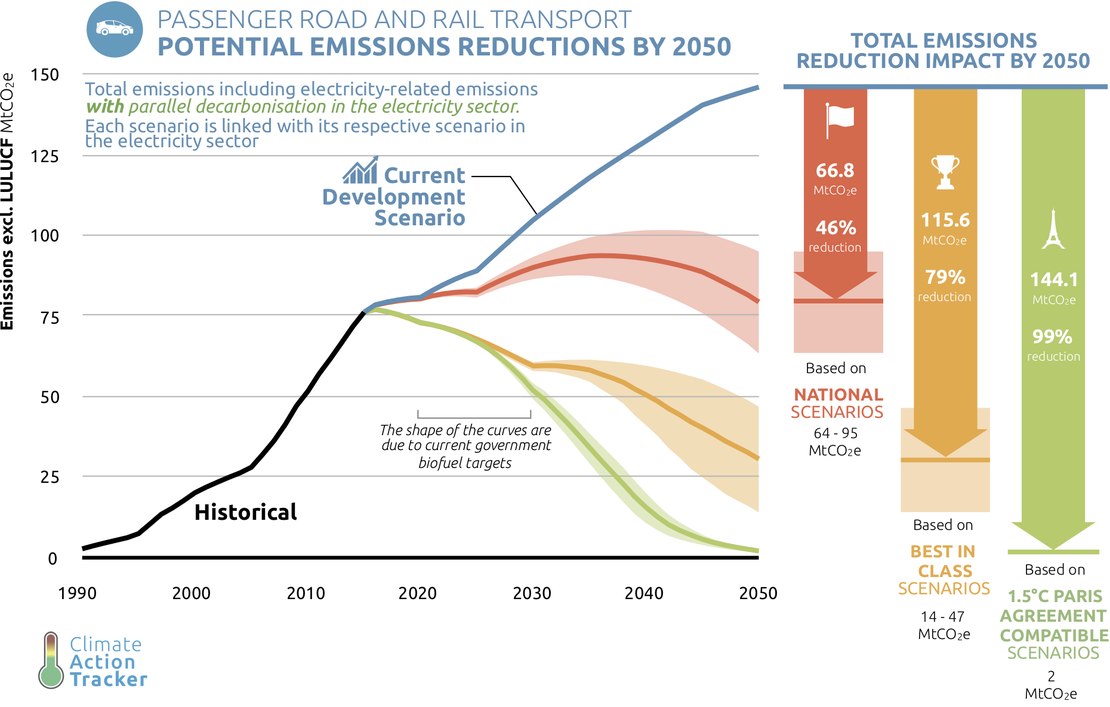
These measures carry important co-benefits such as improving local air quality and reducing congestion in cities.
Indonesia has a very ambitious biofuel blending policy. Biofuels could play a significant role in decarbonisation of the transport sector, although without additional measures related to governance and sustainability certification, palm oil biofuel production will continue to drive deforestation as oil palm plantations expand into Indonesia’s primary forests.
Forestry
Although ambitious interventions in all sectors are urgently needed to prevent fossil fuel lock-ins, the Indonesian forestry sector, with globally significant emissions peaking at 1.6 GtCO2e in 2015 (because of very high peat fires in that El Nino year), has the single largest potential for reducing domestic emissions.
Indonesia can turn its forestry sector into a net sink of carbon emissions by 2030 if (1) it stops peat fires by 2020, (2) it drastically reduces or even phases out emissions from peat degradation via peat restoration by 2030 and (3) it ensures that emissions from deforestation are net-zero by rapidly reducing deforestation rates and reduce deforestation to almost zero by 2040, as well as mounting ambitious afforestation/reforestation programmes. This is more ambitious than Indonesia’s NDC pledge under the Paris Agreement for the forestry sector.
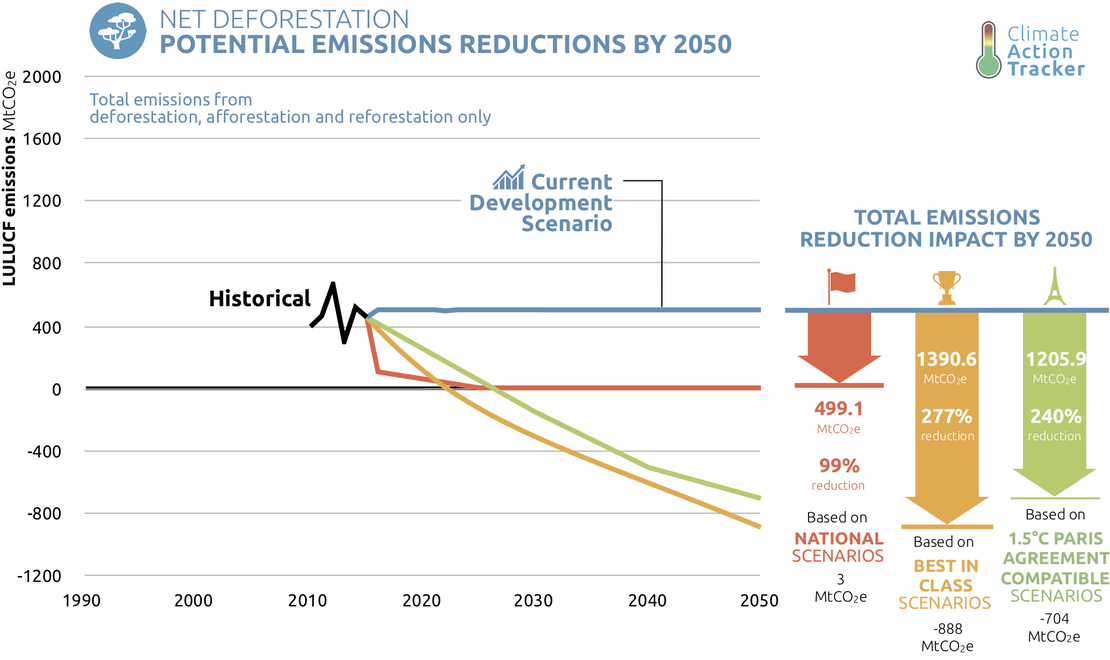
The 2015 peat fires in Indonesia have created political momentum to address this large source of emissions. But sub-national governments require more support to manage diverging interests among stakeholders, and land-swapping schemes for peatlands under concession require revisions to better meet all stakeholder needs. Its success would bring major co-benefits in avoided health impacts, environmental degradation and economic damage.
Stay informed
Subscribe to our newsletter
 Scaling Up Climate Action in Argentina
Scaling Up Climate Action in Argentina
 Scaling Up Climate Action in Australia
Scaling Up Climate Action in Australia
 Scaling Up Climate Action in the EU
Scaling Up Climate Action in the EU
 Scaling Up Climate Action in South Africa
Scaling Up Climate Action in South Africa
 Scaling Up Climate Action in Turkey
Scaling Up Climate Action in Turkey